The laser dazzler industry stands at the threshold of a decade-long expansion trajectory that promises to reshape non-lethal defense and security technology. The market's journey from USD 580.7 million in 2025 to USD 919.3 million by 2035 represents substantial growth, demonstrating the accelerating adoption of advanced optical defense systems and non-lethal countermeasures across military, law enforcement, and security sectors.
The first half of the decade (2025-2030) will witness the market climbing from USD 580.7 million to approximately USD 720.5 million, adding USD 139.8 million in value, which constitutes 41% of the total forecast growth period. This phase will be characterized by the rapid adoption of handheld laser dazzler systems, driven by increasing security concerns and military modernization programs worldwide. Advanced targeting capabilities and portable design features will become standard expectations rather than premium options.
The latter half (2030-2035) will witness sustained growth from USD 720.5 million to USD 919.3 million, representing an addition of USD 198.8 million or 59% of the decade's expansion. This period will be defined by mass market penetration of vehicle-mounted systems, integration with comprehensive security platforms, and seamless compatibility with existing defense infrastructure. The market trajectory signals fundamental shifts in how military and security forces approach crowd control and perimeter defense, with participants positioned to benefit from sustained demand across multiple application segments.
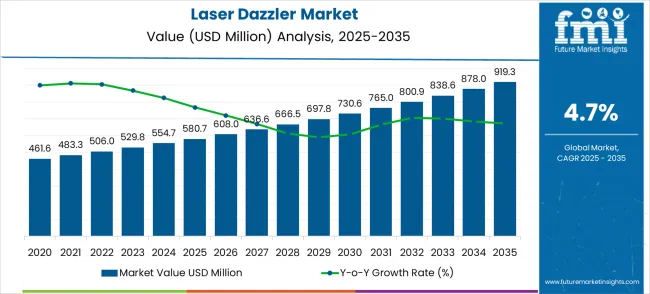
The Laser Dazzler market demonstrates distinct growth phases with varying market characteristics and competitive dynamics. Between 2025 and 2030, the market progresses through its technology adoption phase, expanding from USD 580.7 million to USD 720.5 million with steady annual increments averaging 4.4% growth. This period showcases the transition from basic portable units to advanced systems with enhanced range capabilities and integrated targeting systems becoming mainstream features.
The 2025-2030 phase adds USD 139.8 million to market value, representing 41% of total decade expansion. Market maturation factors include standardization of safety protocols, declining component costs for laser diode arrays, and increasing military awareness of non-lethal engagement benefits reaching 85-90% effectiveness in crowd dispersal applications. Competitive landscape evolution during this period features established defense contractors like B.E. Meyers and THALES Group expanding their laser dazzler portfolios while new entrants focus on compact designs and enhanced battery life.
From 2030 to 2035, market dynamics shift toward advanced integration and multi-platform deployment, with growth accelerating from USD 720.5 million to USD 919.3 million, adding USD 198.8 million or 59% of total expansion. This phase transition logic centers on vehicle-mounted systems, integration with command and control networks, and deployment across diverse security scenarios, becoming standard rather than specialized applications. The competitive environment matures with focus shifting from basic dazzling capability to comprehensive area denial systems and integration with surveillance and detection platforms.
| Metric | Value |
|---|---|
| Market Value (2025) | USD 580.7 million |
| Market Forecast (2035) | USD 919.3 million |
| Growth Rate | 4.7% CAGR |
| Leading Technology | Handheld Type |
| Primary Application | Military Segment |
The market demonstrates strong fundamentals with handheld type systems capturing a dominant share through advanced portability and tactical deployment capabilities. Military applications drive primary demand, supported by increasing defense spending on non-lethal weapons and crowd control systems. Geographic expansion remains concentrated in developed markets with established defense infrastructure, while emerging economies show accelerating adoption rates driven by security modernization and rising defense budgets.
Market expansion rests on three fundamental shifts driving adoption across military and security sectors. 1. Non-lethal engagement demand creates compelling operational advantages through laser dazzler systems that provide immediate threat neutralization without permanent harm, enabling forces to de-escalate situations while maintaining tactical superiority and reducing collateral damage risks. 2. Military modernization programs accelerate as defense forces worldwide seek advanced non-kinetic weapons that complement traditional armaments, enabling precise crowd control and perimeter security applications that align with rules of engagement and international humanitarian law. 3. Security infrastructure enhancement drives adoption from law enforcement agencies and security firms requiring effective crowd dispersal tools that minimize injury risks while maintaining public safety during civil disturbances and protest management.
However, growth faces headwinds from regulatory compliance challenges that vary across jurisdictions regarding the deployment of laser weapons and safety protocols, which may limit operational flexibility in certain environments. Technical limitations also persist regarding effective range and environmental conditions that may reduce system performance in adverse weather or atmospheric conditions that scatter laser energy.
The laser dazzler market presents significant growth opportunities as global security paradigms shift toward non-lethal engagement solutions and military modernization accelerates worldwide. With the market projected to expand from USD 580.7 million in 2025 to USD 919.3 million by 2035 at a 4.7% CAGR, defense contractors and technology providers are positioned to capitalize on structural demand from military forces, law enforcement agencies, and security organizations requiring precise crowd control and threat neutralization capabilities.
The convergence of military modernization programs, increasing security concerns, and regulatory emphasis on non-lethal engagement creates sustained market expansion opportunities. Geographic growth differentials are particularly pronounced in China (6.3% CAGR) and India (5.9% CAGR), where rapid military development and security infrastructure investments drive substantial demand. Technology advancement pathways around integration, automation, and precision targeting offer differentiation opportunities, while specialized applications across military, law enforcement, and security sectors provide diverse revenue streams.
Handheld system dominance and military application leadership indicate established foundations for strategic expansion, while vehicle-mounted systems represent emerging growth vectors. Defense spending increases globally to support sustained procurement, while international peacekeeping missions and crowd control requirements drive operational deployment.
Primary Classification: The market segments by product type into Handheld Type and Vehicle Mounted categories, representing the evolution from individual operator systems to integrated platform solutions for comprehensive area coverage.
Secondary Breakdown: Application segmentation divides the market into Military, Law Enforcement, and Security sectors, reflecting distinct requirements for tactical engagement, crowd control, and perimeter protection.
Regional Classification: Geographic distribution covers North America, Europe, Asia Pacific, Latin America, and the Middle East & Africa, with developed markets leading adoption while emerging economies show accelerating growth patterns driven by security modernization programs.
The segmentation structure reveals technology progression from portable handheld systems toward integrated vehicle-mounted platforms with enhanced range and coverage capabilities, while application diversity spans from military tactical operations to civilian security applications requiring precise non-lethal engagement solutions.
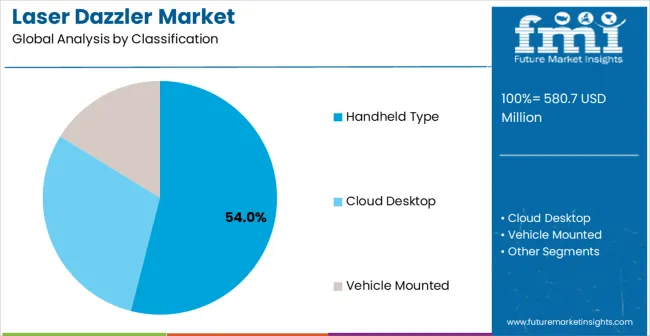
Market Position: Handheld Type systems command the leading position in the Laser Dazzler market through advanced portability features, including lightweight design, extended battery life, and tactical ergonomics that enable individual operators to deploy non-lethal laser engagement capabilities across diverse operational environments.
Value Drivers: The segment benefits from military preference for individual operator systems that provide immediate threat response capabilities without requiring vehicle deployment or infrastructure support. Portable design features enable deployment in urban environments, checkpoint security, and crowd control applications where mobility and rapid response represent critical operational requirements.
Competitive Advantages: Handheld systems differentiate through rapid deployment capability, precision targeting features, and integration with individual combat systems that enhance operator effectiveness while maintaining lightweight operational profiles suitable for extended missions.
Key market characteristics:
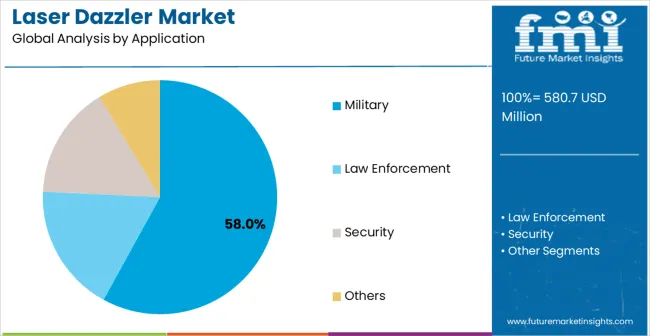
Market Context: Military applications dominate the Laser Dazzler market due to widespread adoption of non-lethal engagement systems and increasing focus on crowd control, checkpoint security, and perimeter defense applications that minimize collateral damage while maintaining operational effectiveness.
Appeal Factors: Military customers prioritize system reliability, environmental durability, and integration with existing command and control infrastructure that enables coordinated deployment across multiple engagement scenarios. The segment benefits from substantial defense budgets and modernization programs that emphasize non-lethal weapons acquisition for peacekeeping and stability operations.
Growth Drivers: Military modernization programs incorporate laser dazzlers as standard equipment for crowd control and area denial applications. At the same time, international peacekeeping missions are increasing the demand for non-lethal engagement capabilities that comply with rules of engagement and minimize civilian casualties.
Market Challenges: Regulatory compliance requirements and international agreements regarding the deployment of laser weapons may limit operational flexibility in certain theater environments or engagement scenarios.
Application dynamics include:
Growth Accelerators: Military modernization drives primary adoption as laser dazzler systems provide non-lethal engagement capabilities that enable threat neutralization without permanent harm, supporting peacekeeping operations and crowd control missions that require precise force application. Security infrastructure demand accelerates market expansion as law enforcement agencies seek effective crowd dispersal tools that minimize injury risks while maintaining operational effectiveness during civil disturbances and protest management scenarios. Defense spending increases worldwide create sustained demand for non-kinetic weapons that complement traditional armaments and provide tactical flexibility in complex operational environments.
Growth Inhibitors: Regulatory compliance challenges vary across jurisdictions regarding the deployment of laser weapons and safety protocols, which may limit operational flexibility and market penetration in regions with restrictive electromagnetic spectrum regulations. Technical performance limitations persist regarding effective range and environmental conditions that may reduce system effectiveness in adverse weather, atmospheric haze, or high-humidity environments that scatter laser energy and diminish dazzling capability. Market fragmentation across multiple military specifications and procurement standards creates compatibility concerns between different system manufacturers and existing defense infrastructure.
Market Evolution Patterns: Adoption accelerates in military and security sectors where non-lethal engagement justifies system costs, with geographic concentration in developed markets transitioning toward mainstream adoption in emerging economies driven by defense modernization and security infrastructure development. Technology development focuses on enhanced range capabilities, improved battery technology, and integration with surveillance systems that optimize target acquisition and engagement effectiveness. The market could face disruption if alternative non-lethal technologies or regulatory restrictions significantly limit laser dazzler deployment in civilian or military applications.
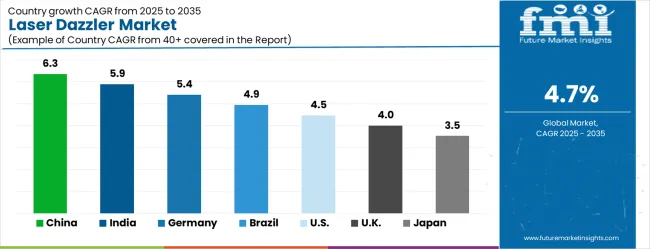
| Country | CAGR (2025-2035) |
|---|---|
| China | 6.3% |
| India | 5.9% |
| Germany | 5.4% |
| Brazil | 4.9% |
| USA | 4.5% |
| UK | 4.0% |
| Japan | 3.5% |
The laser dazzler market demonstrates varied regional dynamics with Growth Leaders including China (6.3% CAGR) and India (5.9% CAGR) driving expansion through military modernization and security infrastructure development. Steady Performers encompass Germany (5.4% CAGR), Brazil (4.9% CAGR), and the USA (4.5% CAGR), benefiting from established defense industries and advanced military technology adoption. Emerging Markets feature the UK (4.0% CAGR) and Japan (3.5% CAGR), where specialized defense applications and security technology integration support consistent growth patterns.
Regional synthesis reveals Asia-Pacific markets leading growth through military modernization and security infrastructure development, while European countries maintain steady expansion supported by defense technology advancement and NATO standardization requirements. North American markets show moderate growth driven by homeland security applications and military technology integration trends.
China establishes market leadership through aggressive military modernization programs and comprehensive security infrastructure development, integrating advanced laser dazzler systems as standard components in crowd control and perimeter defense applications. The country's 6.3% CAGR through 2035 reflects government initiatives promoting non-lethal weapon technology and domestic defense industry capabilities that mandate advanced optical systems in military and security installations. Growth concentrates in major defense manufacturing centers, including Beijing, Guangzhou, and Xi'an, where military technology development showcases integrated laser dazzler systems that appeal to domestic security forces seeking advanced crowd control capabilities and border protection applications.
Chinese manufacturers are developing cost-effective laser dazzler solutions that combine domestic production advantages with advanced features, including precision targeting systems and extended operational range capabilities. Distribution channels through state defense procurement and security equipment suppliers expand market access, while government funding for defense technology development supports adoption across diverse military and security segments.
Strategic Market Indicators:
In New Delhi, Mumbai, and Bangalore, military and security forces are implementing advanced laser dazzler systems as standard equipment for crowd control operations and border security applications, driven by increasing defense spending and modernization programs that emphasize non-lethal engagement capabilities. The market is projected to demonstrate a 5.9% CAGR through 2035, supported by government defense procurement initiatives and security infrastructure development programs that promote advanced optical weapons for military and paramilitary forces. Indian security agencies are adopting laser dazzler systems that provide precise crowd dispersal capabilities and checkpoint security features, particularly appealing in border regions where non-lethal engagement represents critical operational requirements.
Market expansion benefits from growing defense manufacturing capabilities and international technology transfer agreements that enable domestic production of advanced laser systems for military and security applications. Technology adoption follows patterns established in defense electronics, where precision targeting and reliability drive procurement decisions and operational deployment.
Market Intelligence Brief:
Germany's advanced defense technology market demonstrates sophisticated laser dazzler deployment with documented operational effectiveness in military training exercises and security applications through integration with existing tactical systems and command infrastructure. The country leverages engineering expertise in optical technology and defense systems integration to maintain a 5.4% CAGR through 2035. Military centers, including Munich, Hamburg, and Düsseldorf, showcase premium installations where laser dazzlers integrate with comprehensive security platforms and vehicle-mounted systems to optimize area denial and crowd control effectiveness.
German defense contractors prioritize system reliability and NATO compatibility in laser dazzler development, creating demand for premium systems with advanced features, including environmental durability and integration with allied command systems. The market benefits from established defense industry infrastructure and willingness to invest in advanced non-lethal technologies that provide long-term operational benefits and compliance with international humanitarian law requirements.
Market Intelligence Brief:
Brazil's market expansion benefits from diverse security demand, including military modernization in São Paulo and Rio de Janeiro, federal police equipment upgrades, and government security programs that increasingly incorporate non-lethal engagement solutions for crowd control applications. The country maintains a 4.9% CAGR through 2035, driven by rising security concerns and increasing awareness of laser dazzler technology benefits, including precise threat neutralization and reduced collateral damage capabilities.
Market dynamics focus on cost-effective laser dazzler solutions that balance advanced targeting features with affordability considerations important to Brazilian security forces. Growing urbanization creates sustained demand for modern crowd control systems in new security infrastructure and police equipment modernization projects.
Strategic Market Considerations:
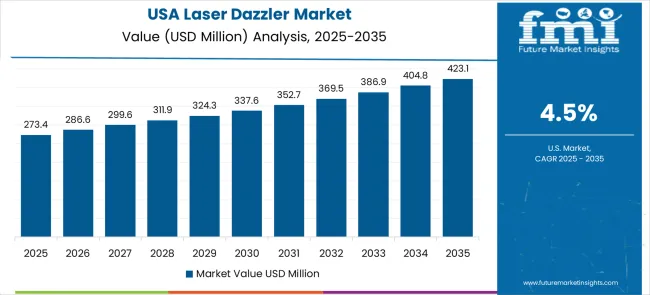
The USA market emphasizes advanced laser dazzler features, including precision targeting systems and integration with comprehensive military platforms that manage area denial, checkpoint security, and crowd control applications through unified command systems. The country is projected to show a 4.5% CAGR through 2035, driven by defense modernization under military equipment upgrades and federal agency demand for reliable non-lethal engagement systems. American military forces prioritize operational effectiveness with laser dazzlers delivering consistent threat neutralization through advanced targeting algorithms and environmental adaptation capabilities.
Technology deployment channels include major defense contractors, specialized security equipment suppliers, and federal procurement programs that support professional installation for complex military applications. Military platform integration capabilities with established defense systems expand market appeal across diverse operational requirements seeking precision and reliability benefits.
Performance Metrics:
Japan demonstrates steady market development with a 3.5% CAGR through 2035, distinguished by the Self-Defense Forces' preference for high-quality laser dazzlers that integrate seamlessly with existing military systems and provide reliable long-term operation in specialized security applications. The market prioritizes advanced features, including precision targeting, environmental durability, and integration with comprehensive defense platforms that reflect Japanese military expectations for technological sophistication and operational excellence.
In London, Portsmouth, and other military centers, British armed forces and security agencies are implementing advanced laser dazzler systems to enhance crowd control capabilities and support peacekeeping operations that align with international humanitarian law requirements and non-lethal engagement protocols. The UK market demonstrates sustained growth with a 4.0% CAGR through 2035, driven by defense modernization programs and security equipment upgrades that emphasize advanced non-kinetic weapons for military and law enforcement applications. British military forces are prioritizing laser dazzler systems that provide precise threat neutralization capabilities while maintaining compliance with rules of engagement and minimizing collateral damage risks, particularly important in urban operations and peacekeeping deployments.
Market expansion benefits from Ministry of Defense procurement programs that mandate non-lethal engagement capabilities in military equipment specifications, creating sustained demand across the UK's defense and security sectors where operational flexibility and precision represent critical requirements. The regulatory framework supports laser dazzler adoption through defense equipment standards and NATO interoperability requirements that promote advanced optical systems aligned with alliance operational capabilities.
Strategic Market Indicators:
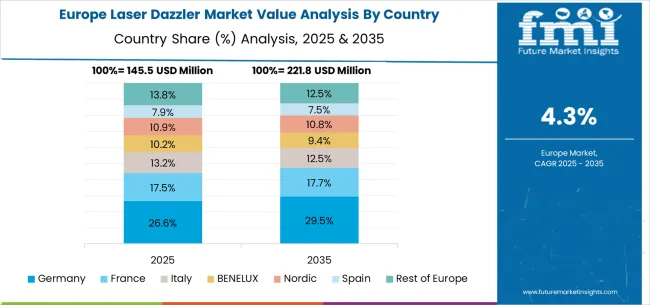
The European Laser Dazzler market is projected to grow from USD 125.4 million in 2025 to USD 198.7 million by 2035, registering a CAGR of 4.7% over the forecast period. Germany is expected to maintain its leadership position with a 28.3% market share in 2025, declining slightly to 27.8% by 2035, supported by its advanced defense technology infrastructure and major military research centers, including Munich and Hamburg.
France follows with a 21.2% share in 2025, projected to reach 21.6% by 2035, driven by comprehensive military modernization programs and defense technology development initiatives. The United Kingdom holds an 18.9% share in 2025, expected to maintain 18.7% by 2035 through specialized defense applications and NATO standardization requirements. Italy commands a 13.7% share, while Spain accounts for 9.8% in 2025. The Rest of Europe region is anticipated to gain momentum, expanding its collective share from 8.1% to 8.5% by 2035, attributed to increasing laser dazzler adoption in Nordic countries and emerging Eastern European defense forces implementing military modernization programs.
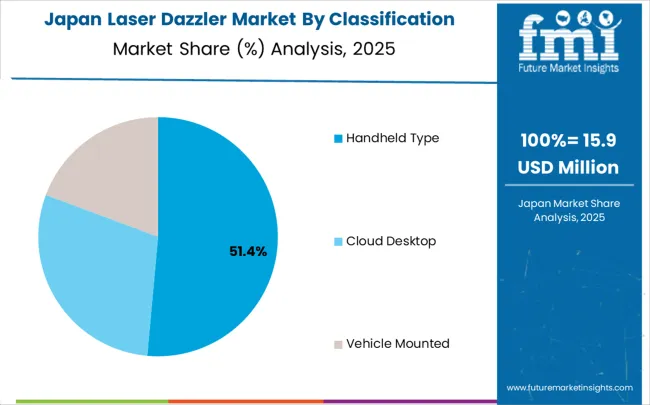
In Japan, the Laser Dazzler market prioritizes Handheld Type systems, which capture the dominant share of military and security installations through advanced features, including precision targeting optimization and seamless integration with existing Self-Defense Forces equipment infrastructure. Japanese military forces emphasize reliability, precision, and long-term operational excellence, creating demand for handheld systems that provide tactical deployment capabilities and adaptive targeting control based on operational requirements and threat assessment scenarios. Vehicle-mounted systems maintain a secondary market position primarily in specialized applications and perimeter defense installations where area coverage functionality meets operational requirements without portable deployment features.
Market Characteristics:
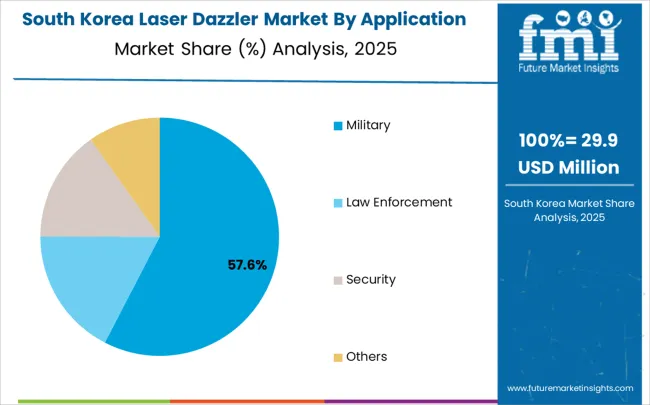
In South Korea, the market structure favors international defense companies, including THALES Group, Lockheed Martin, and B.E. Meyers, which maintain dominant positions through comprehensive product portfolios and established military procurement networks supporting both armed forces and security installations. These providers offer integrated solutions combining advanced laser dazzler systems with professional installation services and ongoing technical support that appeal to Korean military forces seeking reliable non-lethal engagement systems. Local defense contractors and system integrators capture moderate market share by providing localized service capabilities and competitive pricing for standard military installations. At the same time, domestic manufacturers focus on specialized applications and cost-effective solutions tailored for Korean defense characteristics.
Channel Insights:
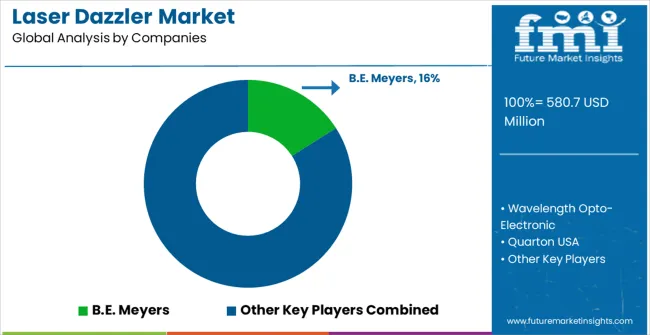
The Laser Dazzler market operates with moderate concentration, featuring approximately 12-15 meaningful participants, where leading companies control roughly 45-50% of the global market share through established defense industry relationships and comprehensive technology portfolios. Competition emphasizes advanced targeting capabilities, system reliability, and military platform integration rather than price-based rivalry.
Market Leaders encompass B.E. Meyers, THALES Group, and Lockheed Martin, which maintain competitive advantages through extensive military technology expertise, global defense contractor networks, and comprehensive system integration capabilities that create customer switching costs and support premium pricing. These companies leverage decades of defense industry experience and ongoing research investments to develop advanced laser dazzler systems with precision targeting and environmental durability features.
Technology Challengers include Wavelength Opto-Electronic, Quarton USA, and Electro Optic Systems, which compete through specialized optical technology focus and innovative targeting interfaces that appeal to military customers seeking advanced precision capabilities and tactical flexibility. These companies differentiate through rapid technology development cycles and specialized military application focus.
Regional Specialists feature companies like Lasence, Beijing JingPinTeZhuang Science and Technology, and Xi'an Super Optoelectronic Equipment, which focus on specific geographic markets and specialized applications, including vehicle-mounted systems and integrated platform solutions. Market dynamics favor participants that combine reliable hardware with advanced targeting software, including precision rangefinding and automatic power adjustment capabilities. Competitive pressure intensifies as traditional defense contractors expand into laser weapon systems. At the same time, specialized optical companies challenge established players through innovative targeting solutions and cost-effective platforms targeting specialized military segments.
| Item | Value |
|---|---|
| Quantitative Units | USD 580.7 million |
| Product Type | Handheld Type, Vehicle Mounted |
| Application | Military, Law Enforcement, Security |
| Regions Covered | North America, Europe, Asia Pacific, Latin America, Middle East & Africa |
| Countries Covered | China, India, Germany, Brazil, the USA, the UK, Japan, and 25+ additional countries |
| Key Companies Profiled | B.E. Meyers, Wavelength Opto-Electronic, Quarton USA, Lasence, Electro Optic Systems, THALES Group, Lockheed Martin, Bharat Electronics |
| Additional Attributes | Dollar sales by product type and application categories, regional adoption trends across North America, Europe, and Asia-Pacific, competitive landscape with defense contractors and technology providers, military preferences for precision targeting and system reliability, integration with military platforms and command systems, innovations in targeting algorithms and environmental durability, and development of vehicle-mounted solutions with enhanced range and coverage capabilities. |
The global laser dazzler market is estimated to be valued at USD 580.7 million in 2025.
The market size for the laser dazzler market is projected to reach USD 919.3 million by 2035.
The laser dazzler market is expected to grow at a 4.7% CAGR between 2025 and 2035.
The key product types in laser dazzler market are handheld type, cloud desktop and vehicle mounted.
In terms of application, military segment to command 58.0% share in the laser dazzler market in 2025.






Our Research Products

The "Full Research Suite" delivers actionable market intel, deep dives on markets or technologies, so clients act faster, cut risk, and unlock growth.

The Leaderboard benchmarks and ranks top vendors, classifying them as Established Leaders, Leading Challengers, or Disruptors & Challengers.

Locates where complements amplify value and substitutes erode it, forecasting net impact by horizon

We deliver granular, decision-grade intel: market sizing, 5-year forecasts, pricing, adoption, usage, revenue, and operational KPIs—plus competitor tracking, regulation, and value chains—across 60 countries broadly.

Spot the shifts before they hit your P&L. We track inflection points, adoption curves, pricing moves, and ecosystem plays to show where demand is heading, why it is changing, and what to do next across high-growth markets and disruptive tech

Real-time reads of user behavior. We track shifting priorities, perceptions of today’s and next-gen services, and provider experience, then pace how fast tech moves from trial to adoption, blending buyer, consumer, and channel inputs with social signals (#WhySwitch, #UX).

Partner with our analyst team to build a custom report designed around your business priorities. From analysing market trends to assessing competitors or crafting bespoke datasets, we tailor insights to your needs.
Supplier Intelligence
Discovery & Profiling
Capacity & Footprint
Performance & Risk
Compliance & Governance
Commercial Readiness
Who Supplies Whom
Scorecards & Shortlists
Playbooks & Docs
Category Intelligence
Definition & Scope
Demand & Use Cases
Cost Drivers
Market Structure
Supply Chain Map
Trade & Policy
Operating Norms
Deliverables
Buyer Intelligence
Account Basics
Spend & Scope
Procurement Model
Vendor Requirements
Terms & Policies
Entry Strategy
Pain Points & Triggers
Outputs
Pricing Analysis
Benchmarks
Trends
Should-Cost
Indexation
Landed Cost
Commercial Terms
Deliverables
Brand Analysis
Positioning & Value Prop
Share & Presence
Customer Evidence
Go-to-Market
Digital & Reputation
Compliance & Trust
KPIs & Gaps
Outputs
Full Research Suite comprises of:
Market outlook & trends analysis
Interviews & case studies
Strategic recommendations
Vendor profiles & capabilities analysis
5-year forecasts
8 regions and 60+ country-level data splits
Market segment data splits
12 months of continuous data updates
DELIVERED AS:
PDF EXCEL ONLINE
Laser Frequency Splitting and Mode Competition Teaching Instrument Market Size and Share Forecast Outlook 2025 to 2035
Laser Component Analyzer Market Size and Share Forecast Outlook 2025 to 2035
Laser-Assisted Smart Lathes Market Size and Share Forecast Outlook 2025 to 2035
Laser Drilling Equipment Market Size and Share Forecast Outlook 2025 to 2035
Laser Transverse Mode Teaching Instrument Market Forecast and Outlook 2025 to 2035
Laser Welding Equipment Market Forecast and Outlook 2025 to 2035
Laser Welding Market Size and Share Forecast Outlook 2025 to 2035
Laser Ablation Systems Market Size and Share Forecast Outlook 2025 to 2035
Laser Measurement Integrating Sphere Market Size and Share Forecast Outlook 2025 to 2035
Laser Safety Cloths Market Size and Share Forecast Outlook 2025 to 2035
Laser Cable Marking Market Size and Share Forecast Outlook 2025 to 2035
Laser Cladding Market Size and Share Forecast Outlook 2025 to 2035
Laser Marking Equipment Market Size and Share Forecast Outlook 2025 to 2035
Laser Cutting Machines Market Size and Share Forecast Outlook 2025 to 2035
Laser Wire Marking Systems Market Size and Share Forecast Outlook 2025 to 2035
Laser Photomask Market Size and Share Forecast Outlook 2025 to 2035
Laser Measuring Instrument Market Size and Share Forecast Outlook 2025 to 2035
Laser Welding Machine Market Size and Share Forecast Outlook 2025 to 2035
Laser Technology Market Size and Share Forecast Outlook 2025 to 2035
Laser Interferometer Market Size and Share Forecast Outlook 2025 to 2035

Thank you!
You will receive an email from our Business Development Manager. Please be sure to check your SPAM/JUNK folder too.
Chat With
MaRIA